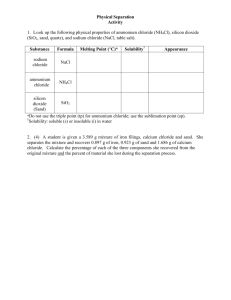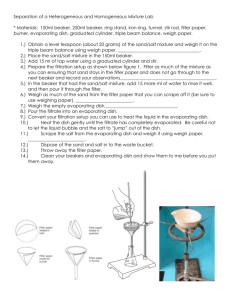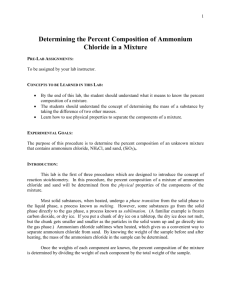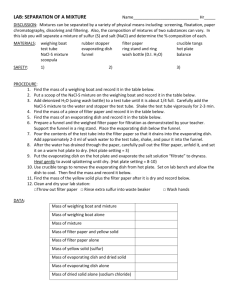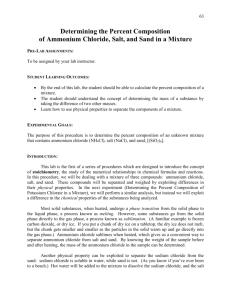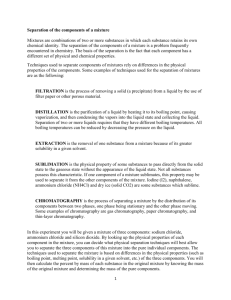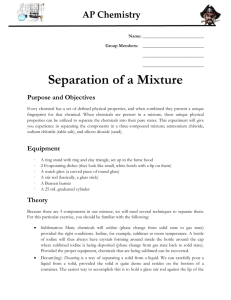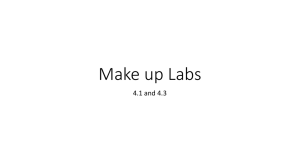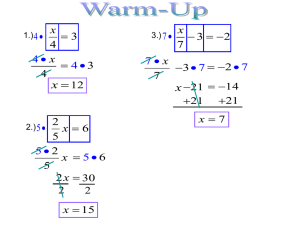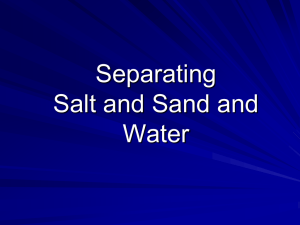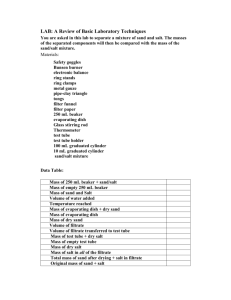Observations of Substances
advertisement
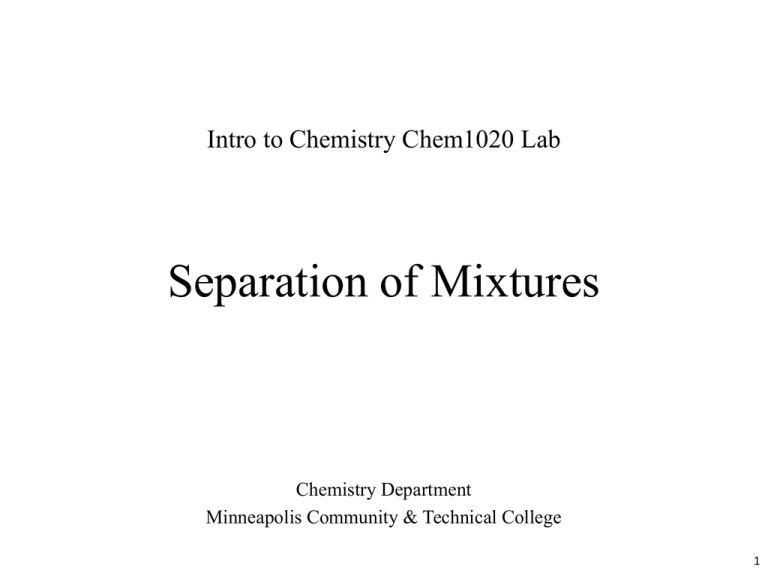
Intro to Chemistry Chem1020 Lab Separation of Mixtures Chemistry Department Minneapolis Community & Technical College 1 Overview • Part I Schematic demonstration of the overall procedure • Part II Mass measurement • Part III Physical method: sublimation • Part IV Physical method: filtration • Part V Calculation 2 Part I. Procedure In this experiment, you will be given a solid mixture that contains three substances. They are ammonium chloride, sodium chloride, and sand. Your goal is to separate the mixture into these three substances, then determine the mass and composition percentage of each substance. Two physical methods, sublimation and filtration, will be used to separate the components. Make sure to record this unknown number on your data sheet. 3 8. Weigh the paper and the sand after drying (Mpaper+sand). 1. Weigh the empty evaporating dish (Mdish) 2. Add solid mixture 7. Add water which dissolves sodium chloride only. Filter out the sodium chloride and water with filter paper. Only sand will be left on the paper. 4. Heat the dish. Ammonium chloride 6. Weigh a piece sublimes into gas 5. Weigh the dish with just of filter paper 3. Weigh the dish with the and escapes. sodium chloride and sand left (Mpaper). mixture (Mdish+mixture) (Mdish+mixture after heating) 4 Part II. Mass Measurement 1. Always use the same balance during one experiment and record the weighing balance number. paper balance number 2. Always have a piece of weighing paper on the balance. 3. Before putting your object on the balance, press the “Zero” or “Tare” button to zero it. “zero” button A top-loading balance 4. Carefully put the object on the balance, and record all digits shown in the display (including zeros) with the unit of “g”. Example: this evaporating dish is 36.66 g. 5. Avoid spilling. If it ever happens, alert the instructor. 6. Never put a hot object on the balance! 5 Part III. Sublimation Since the gaseous ammonium chloride is hazardous when inhaled, perform this procedure in the fume hood!!! • Heat the mixture in the dish with a Bunsen burner. Review the next slide for how to light up the burner. • Stop heating when there is no more white fume forming (what substance is it?) and no yellow color left in the solid mixture. • Carry the hot evaporating dish back to your station with a beaker. 6 How to Light up a Bunsen Burner? An Important Skill in a Chem Lab 1. Connect the burner and the gas valve with a rubber hose. 2. Gently close the gas valve of the burner. 5. Approach a lit stick or a striker to the top of the barrel. 4. Turn to open the gas valve. Meanwhile quickly turn on the gas valve of the burner. A striker 3. Gently close the air valve of the burner. Hottest spot 6. Turn on the air valve until you see two blue cones formed in the flame. 7 Part IV. Filtration Folding the filter paper John D. Funnel Clay triangle 1. Weigh and label 1. Open the paper cone with 3 layers on one side and one layer on the other side. John D. 2. Fold into halves with name facing inside Filtration apparatus 2. Wet the paper with water. 3. Fold into halves again 8 3. Pour the sand, sodium chloride, water mixture into the filter paper cone. Rinse the evaporating dish with distilled water to transfer all of the solid. 4. Wash the solid remaining on the paper with more water to remove residual sodium chloride. John D. 5. What is remaining on the paper now? Remove the paper and open it up onto a watch glass. Dry in the oven. John D. 6. Weigh the dried sand with the filter paper. 9 Part V. Sample Calculation Data: Mevaporating dish 36.66 g Mdish+mixture 39.06 g Mdish+mixture (after heating) 38.05 g Mfilter paper 0.82 g Mpaper+sand 1.24 g For some reasons that will be explained later in the semester, when you do subtraction in this calculation, always keep two decimal places. However it is more complicated with dividing. To make it simpler, always keep one decimal place in this calculation. 10 Calculation: Mmixture = Mdish+mixture - Mevaporating dish =39.06 g – 36.66 g = 2.40 g Mammonium chloride = Mdish+mixture - Mdish+mixture (after heating) =39.06 g – 38.05 g = 1.01 g Msand = Mpaper+sand - Mpaper =1.24 g – 0.82 g = 0.42 g Msodium chloride = Mmixture - Mammonium chloride - Msand =2.40 g – 1.01 g – 0.42 g = 0.97 g 1.01g % of ammonium chloride 100% 42.1% 2.40g 0.42g % of sand 100% 17.5% 2.40g 0.97g % of sodium chloride 100% 40.4% 2.40g 11 • Wash all used glassware clean with tap water and put them back to the bench. • Dispose of the used sand into the designated waste container. • Dispose of the used filter paper into trash. • Wipe your bench and fume hood with wet sponge. • Ask your instructor to sign you out….then you are ready to leave. • Finish the lab report (including both data sheet and postlab questions) after the lab. Feel free to ask instructors questions, but never ever copy other students’ answers. • Turn in the lab report the next time when you are expected to come to the lab. • Don’t forget to prepare for the next lab before you come next time. 12
